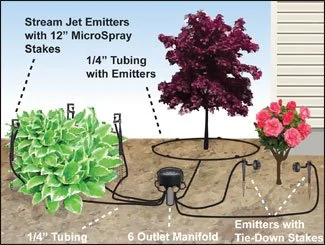Introduction
Installing a watering system for your garden is one of the smartest investments you can make as a gardener. Not only does it save time and effort, but it also ensures your plants receive consistent and adequate hydration—key to healthy growth and vibrant blooms. Whether you have a small backyard garden or a larger landscape, a well-planned watering system can boost your garden’s productivity and conserve water.
In this guide, we’ll walk you through everything you need to know about installing a garden watering system. From selecting the right type to step-by-step installation tips, this article combines expert advice with practical solutions to help you achieve a thriving garden with minimal hassle.
Why Install a Garden Watering System?
Automated watering systems offer several advantages over manual watering methods. Here are some compelling reasons to consider installation:
- Consistent Water Delivery: Automated systems deliver water evenly and on schedule, reducing the risk of under- or overwatering.
- Water Conservation: Drip irrigation and soaker hoses target the roots directly, minimizing evaporation and runoff.
- Time Savings: Once installed, these systems operate independently, freeing you from daily watering chores.
- Healthier Plants: Proper hydration promotes stronger roots and better resistance to pests and diseases.
Experts in horticulture emphasize that tailored irrigation can increase crop yield and garden health substantially. According to the EPA, efficient watering systems can reduce outdoor water use by up to 50%.
Types of Garden Watering Systems
Drip Irrigation
Drip irrigation delivers water slowly and precisely at the base of plants through a network of tubes and emitters. It’s ideal for vegetable gardens, flower beds, and shrubs.
- Pros: Water efficient, reduces weed growth, minimizes leaf diseases.
- Cons: Initial setup can be complex; emitters may clog without proper maintenance.
Soaker Hoses
Soaker hoses release water along their length and are usually laid on the soil surface or buried slightly.
- Pros: Easy to install, affordable, suitable for garden beds.
- Cons: Less precise than drip systems; can waste water if placed incorrectly.
Sprinkler Systems
Sprinklers spray water over a broad area and are commonly used for lawns and larger garden spaces.
- Pros: Covers large areas, easy to automate.
- Cons: Higher water loss due to evaporation and wind drift.
Steps to Install Your Garden Watering System
1. Plan Your Layout
Start by assessing your garden’s size, plant types, and sun exposure. Sketch a layout marking plant locations and water sources. This helps determine the system type and the length of tubing or hoses needed.
2. Gather Materials and Tools
Common materials include:
- Main tubing or hoses
- Emitters or sprinkler heads
- Timers or controllers
- Connectors and stakes
- Backflow preventer (to protect your water supply)
You’ll also need tools like scissors, a shovel, and a pressure regulator.
3. Install the Main Lines
Connect the main tubing to your outdoor faucet or water source. Use connectors to branch out to different zones if necessary. Lay the tubes along your garden beds, securing them with stakes.
4. Attach Emitters or Sprinklers
Place emitters near plant roots or position sprinkler heads to cover lawn areas. For drip systems, space emitters based on plant water needs and soil type.
5. Set Up Automation
Install a timer or irrigation controller to schedule watering times. This ensures plants get water early in the morning or late evening when evaporation rates are lowest.
6. Test and Adjust
Run the system for a full cycle, checking for leaks, clogs, or dry spots. Adjust emitter flow or sprinkler angles as needed for uniform coverage.
Maintenance Tips for Longevity and Efficiency
- Regularly Inspect Tubing and Emitters: Clear clogs and repair leaks promptly.
- Seasonal Adjustments: Modify watering schedules based on weather and plant growth stages.
- Flush the System: Periodically flush tubing to remove sediment.
- Winterize Your System: Drain and store components to prevent freeze damage in cold climates.
Real-World Example
A suburban gardener in California reported reducing water usage by 40% after switching to a drip irrigation system. Over two growing seasons, their vegetable yield increased by 25%, demonstrating the tangible benefits of efficient watering.
Conclusion
Installing a watering system for your garden is a practical way to enhance plant health, conserve water, and save time. By choosing the right system—whether drip irrigation, soaker hoses, or sprinklers—and following a clear installation plan, you can create a sustainable garden that thrives year-round.
Remember, effective irrigation is not just about technology but also about understanding your garden’s unique needs. Take the time to plan, install, and maintain your watering system carefully, and you’ll enjoy the rewards of a lush, vibrant garden with less effort.
Ready to transform your garden’s watering routine? Start planning your system today and watch your plants flourish!
